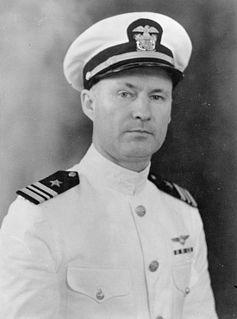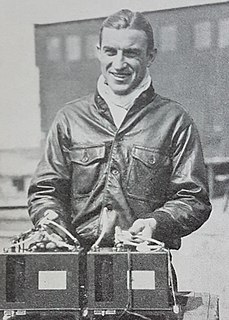Related Research Articles

USS Enterprise (CV-6) was a Yorktown-class carrier built for the United States Navy during the 1930s. She was the seventh U.S. Navy vessel of that name. Colloquially called "The Big E", she was the sixth aircraft carrier of the United States Navy. Launched in 1936, she was one of only three American carriers commissioned before World War II to survive the war. She participated in more major actions of the war against Japan than any other United States ship. These actions included the attack on Pearl Harbor — 18 Douglas SBD Dauntless dive bombers of her Air Group arrived over the harbor during the attack; seven were shot down with eight airmen killed and two wounded, making her the only American aircraft carrier with men at Pearl Harbor during the attack and the first to sustain casualties during the Pacific War — the Battle of Midway, the Battle of the Eastern Solomons, the Battle of the Santa Cruz Islands, various other air-sea engagements during the Guadalcanal Campaign, the Battle of the Philippine Sea, and the Battle of Leyte Gulf. Enterprise earned 20 battle stars, the most for any U.S. warship in World War II, and was the most decorated U.S. ship of World War II. She was also the first American ship to sink a full-sized enemy warship after the Pacific War had been declared when her aircraft sank the Japanese submarine I-70 on 10 December 1941. On three occasions during the war, the Japanese announced that she had been sunk in battle, inspiring her nickname "The Grey Ghost". By the end of the war, her planes and guns had downed 911 enemy planes, sunk 71 ships, and damaged or destroyed 192 more.

Donald Bradley Duncan (1896–1975) was an admiral in the United States Navy, who played an important role in aircraft-carrier operations during World War II.

USS Bon Homme Richard (CV/CVA-31) was one of 24 Essex-class aircraft carriers completed during or shortly after World War II for the United States Navy. She was the second US Navy ship to bear the name, the first one being named for John Paul Jones's famous Revolutionary War frigate by the same name. Jones had named that ship, usually rendered in more correct French as Bonhomme Richard, to honor Benjamin Franklin, the American Commissioner at Paris, whose Poor Richard's Almanac had been published in France under the title Les Maximes du Bonhomme Richard.

Esther Dyson is a Swiss-born American investor, journalist, author, businesswoman, commentator and philanthropist. She is a leading angel investor focused on health care, open government, digital technology, biotechnology, and outer space. Dyson's career focuses on health and continues to invest in health and technology startups.

Sir James Dyson is a British inventor, industrial designer, farmer and billionaire entrepreneur who founded Dyson Ltd. He is best known as the inventor of the dual cyclone bagless vacuum cleaner, which works on the principle of cyclonic separation. According to the Sunday Times Rich List 2021, he is the fourth richest person in the UK with an estimated net worth of £16.3 billion.
Charles Stark "Doc" Draper was an American scientist and engineer, known as the "father of inertial navigation". He was the founder and director of the Massachusetts Institute of Technology's Instrumentation Laboratory, later renamed the Charles Stark Draper Laboratory, which made the Apollo Moon landings possible through the Apollo Guidance Computer it designed for NASA.

Charles Frank Bolden Jr. is a former NASA administrator, a retired United States Marine Corps Major General, and a former astronaut who flew on four Space Shuttle missions.
Charlie Henry Dyson was an American businessman and philanthropist. He was founder of the Dyson Kissner-Moran Corporation and the Dyson Foundation.

Charles Emery Rosendahl was a highly decorated Vice Admiral in the United States Navy, and an advocate of lighter-than-air flight.

Aubrey Wray Fitch was an admiral of the United States Navy during World War II. A naval aviator, he held important aviation-related commands both at sea and on shore from the 1920s onward. He also served as Superintendent of the United States Naval Academy.

Benjamin Franklin Isherwood was an engineering officer in the United States Navy during the early days of steam-powered warships. He served as a ship's engineer during the Mexican–American War, and after the war did experimental work with steam propulsion. Rising to the rank of rear admiral, as Engineer-in-Chief of the Navy during the Civil War, he helped to found the Navy's Bureau of Steam Engineering.

William Henry Dyson was an Australian illustrator and political cartoonist. In 1931 he was regarded as 'one of the world's foremost black and white artists', and in 1980, 'Australia's greatest cartoonist'.

USS Dyson (DD-572) was a Fletcher-class destroyer of the United States Navy. She was named for Rear Admiral Charles W. Dyson (1861–1930).

John Halligan Jr. was an admiral of the United States Navy in the early 20th century.

Apollo Soucek was a vice admiral in the United States Navy, who was a record-breaking test pilot during 1929 and 1930, served in World War II, and was commander of Carrier Division Three during the Korean War, ending his career as chief of the Bureau of Aeronautics.

Felix Budwell Stump was an admiral in the United States Navy and Commander, United States Pacific Fleet from July 10, 1953 until July 31, 1958.

Charles Alan Pownall was a Vice admiral in the United States Navy and Governor of Guam. He was the third military Governor and first naval Governor of Guam following the United States recapture of the island from the Japanese. After conflict with the Guam Congress in 1948, Pownall replaced many Congressmen with his own appointments, whom the Guamanians refused to recognize. The ensuing protest persuaded President Truman to transfer control of the island away from the Navy. As a consequence, Charles Pownall was the last military governor of Guam.

Herbert William Charles Kempton Dyson, M.I.Struct.E. (1880–1944), known professionally as H. Kempton Dyson, was an English structural engineer, civil engineer, architect, editor and author who specialised in reinforced concrete structures. He was a founder member and the first permanent secretary of the Concrete Institute, which became the Institution of Structural Engineers. He designed the Central Bandstand, Herne Bay in 1924.
David Ryan Just is an American behavioral economist at Cornell University.
Stephen Hitchcock Rogers was a career Foreign Service officer who served as the American Ambassador Extraordinary and Plenipotentiary to Swaziland from 1990 until 1993.
References
- This article incorporates text from the public domain Dictionary of American Naval Fighting Ships .